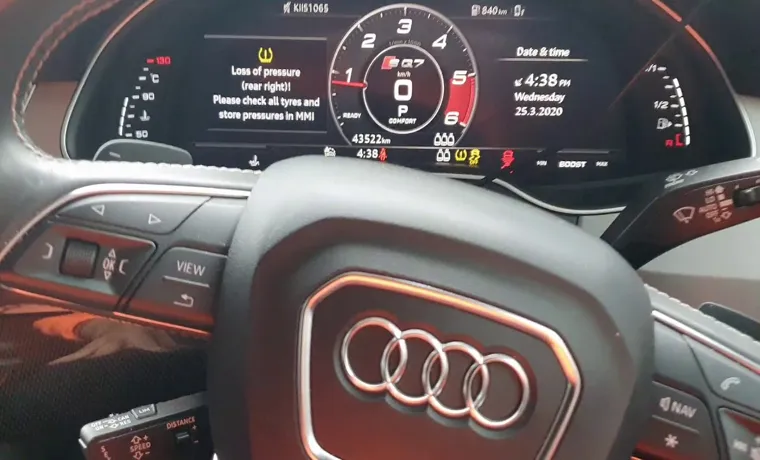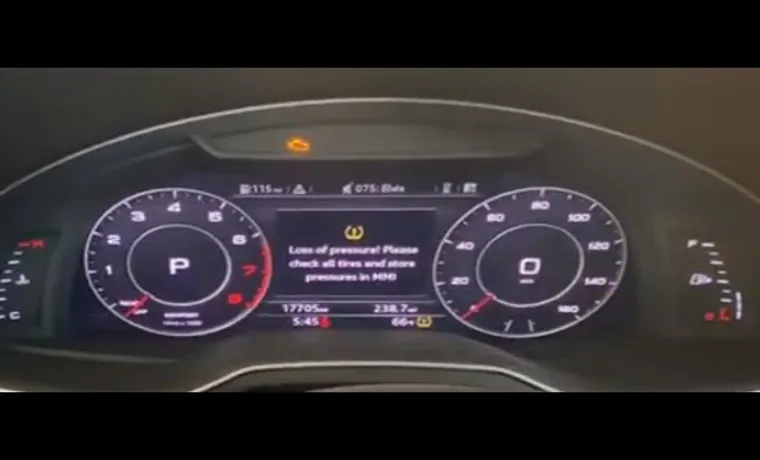Maintaining your Audi Q7’s tire pressure is essential to ensure a smooth ride and safe driving experience. Having the correct tire pressure not only increases fuel efficiency but also maximizes tire life and handling. But, how do you check Audi Q7 tire pressure? In this blog post, we’ll guide you through the step-by-step process of checking your Audi Q7’s tire pressure.
Whether you’re a new car owner or a seasoned one, this guide will provide you with the necessary information to keep your tires in top shape. So, let’s dive in and learn how to maintain your Audi Q7’s tire pressure like a pro!
Table of Contents
Why Tire Pressure Matters
Checking the tire pressure of your Audi Q7 is a crucial aspect of ensuring your car runs smoothly and safely. Proper tire pressure can be beneficial in several ways, such as improving fuel economy, providing better handling, and extending the life of your tires. The process of checking your tire pressure is quick and straightforward.
First, you will need a tire pressure gauge, which can be found at most auto stores. Locate the valve stem on your tire and remove the cap. Place the gauge over the valve stem and press down firmly to get a reading.
The recommended tire pressure for the Audi Q7 is typically around 35 pounds per square inch (PSI), but it is always best to check your owner’s manual or consult with a professional. It is important to note that tire pressure should be checked when the tires are cold, as driving on them can cause an increase in pressure. With regular checks, you can ensure that your tires are always properly inflated, providing you with a smooth and safe driving experience.

Locating the Tire Pressure Monitoring System (TPMS)
If you’re wondering how to check the tire pressure on your Audi Q7, you’ll first need to locate the tire pressure monitoring system (TPMS). Typically, the TPMS is found on the dashboard, which displays the tire pressure for each wheel. However, the location may vary by model and year.
In some cases, the TPMS may be accessed through the infotainment system or even via a dedicated app. It’s essential to ensure that your tires have the correct pressure, as it can affect your vehicle’s handling, fuel efficiency, and safety. To check the pressure level, you will need a tire pressure gauge, which can be picked up inexpensively at an auto parts store or online.
Simply attach the gauge to the valve stem on the tire and measure the pressure level. You can then compare the reading to the recommended pressure, which should be listed in your vehicle’s manual or on the driver’s side doorjamb. Maintaining the correct tire pressure is an important part of keeping your Audi Q7 running smoothly and safely on the road.
Preparing to Check Tire Pressure
If you’re driving an Audi Q7, it’s important to keep track of your tire pressure for optimal performance and safety. Before you start checking your tire pressure, make sure you have a reliable tire gauge and a clear understanding of your car’s recommended pressure level. You can usually find this information in your owner’s manual or on a sticker located on the driver’s side door jamb.
It’s also important to check your tires when they’re cold, as excessive heat from driving can cause the pressure to fluctuate. Once you have everything you need, remove the valve cap from your tire and press the gauge firmly onto the valve stem. You should hear a brief hissing sound as you do this.
After a few seconds, the gauge will show you the tire pressure reading. If it’s within the recommended range, you’re good to go. If it’s too low or too high, adjust the pressure accordingly until you reach the correct level.
Repeat this process for all four tires, and don’t forget to replace the valve caps when you’re finished. By keeping your tire pressure in check, you’ll ensure a smooth and safe ride every time.
Checking Tire Pressure
Are you wondering how to check the tire pressure on your Audi Q7? It’s a simple process that can help maintain your car’s performance and ensure your safety on the road. Begin by locating the tire pressure information, which is typically found on the driver’s side door jamb or in the owner’s manual. Next, use a tire pressure gauge to check the tire pressure of each tire.
Take note of the pressure reading and compare it to the recommended pressure listed in the tire pressure information. If the pressure is too low, inflate the tire with an air compressor or visit a tire shop to have it filled. Finally, re-check the pressure to ensure it matches the recommended level.
Checking your Audi Q7’s tire pressure regularly can improve fuel efficiency, extend tire life, and prevent accidents due to underinflated or overinflated tires.
Adjusting Tire Pressure
If you’re an Audi Q7 owner, checking tire pressure is an essential task you should master to keep your vehicle in tip-top condition. Tire pressure is crucial, as it can affect your car’s fuel economy, ride quality, handling, and most importantly, your safety. Checking your Audi Q7 tire pressure is a cinch.
First, make sure your tires are cold as heat can increase tire pressure readings. Then locate your vehicle’s recommended PSI (pounds per square inch) level either in your owner’s manual or on the tire placard located inside your driver’s side door. Finally, use a tire pressure gauge to check each tire’s pressure, compare it to the recommended level and adjust accordingly using a tire inflator.
Keep in mind that failing to maintain proper tire pressure can decrease your tire’s lifespan, and cause wear and tear, increasing the risk of accidents.
Re-checking Tire Pressure
If you own an Audi Q7, it’s crucial to check the tire pressure regularly as it can affect your car’s performance. The ideal tire pressure for Audi Q7 is typically between 33-34 PSI for all the tires. To ensure accurate readings, always check the tire pressure when the tires are cold.
First, locate the tire pressure monitoring system (TPMS) button on your dashboard near the steering wheel. Press and hold the TPMS button until a beep sound is heard. This will activate the TPMS and show you the current pressure readings for all your tires.
If the readings are lower than recommended, use a tire pressure gauge to fill air into your tires. You can find the recommended air pressure for your vehicle in your owner’s manual or on the driver’s side door jamb. Remember that overinflation is just as damaging as underinflation, so make sure to fill your tires with precision.
By monitoring and adjusting your tire pressure on a regular basis, you’ll prolong the lifespan of your tires and ensure your Audi Q7 delivers optimal performance and a smooth driving experience.
Conclusion
Checking your Audi Q7 tire pressure is as easy as pie (and we’re not talking about the pie you’ll eat while waiting at the mechanic). With a few simple steps, you’ll be cruising the roads with the perfect amount of air in your tires. Remember, proper tire pressure is key to a safe and efficient driving experience.
So, take a few minutes out of your day to check those tires, and you’ll be rewarded with smoother rides, longer lasting tires, and ultimately, a happier you.”
FAQs
What is the recommended tire pressure for the Audi Q7?
The recommended tire pressure for the Audi Q7 is typically 33 PSI for the front tires and 36 PSI for the rear tires.
Can I check my Audi Q7 tire pressure myself?
Yes, you can check your Audi Q7 tire pressure yourself by using a tire pressure gauge and consulting your owner’s manual for the recommended pressure.
How often should I check my Audi Q7 tire pressure?
It is recommended to check your Audi Q7 tire pressure at least once a month and before long trips or when the weather changes.
What are the consequences of driving with low tire pressure in my Audi Q7?
Driving with low tire pressure in your Audi Q7 can lead to reduced fuel efficiency, uneven tire wear, decreased traction and handling, and even tire failure.
Can I use the tire pressure monitoring system (TPMS) in my Audi Q7 to check tire pressure?
Yes, the TPMS in your Audi Q7 can be used to check your tire pressure, but it is still recommended to use a tire pressure gauge for accuracy.
Is it normal for tire pressure to fluctuate in my Audi Q7?
Yes, tire pressure can fluctuate in your Audi Q7 due to changes in temperature, altitude, or driving conditions. However, it is still important to maintain the recommended pressure.
Where can I find the recommended tire pressure for my specific Audi Q7 model?
The recommended tire pressure for your specific Audi Q7 model can be found in your owner’s manual or on the sticker located on the driver’s side doorjamb.



